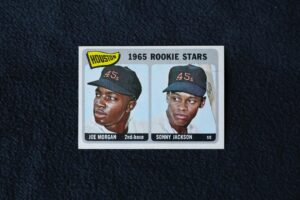If you’ve recently discovered a box of baseball cards in your attic or decided to part with your childhood collection, you might be wondering how to start selling baseball cards. There’s no need to worry, as this guide helps beginners sell their baseball cards. With step-by-step instructions and advice on managing your collection, you’ll be well on your way from rookie to pro in no time.
Step 1: Organize Your Collection
Before selling your baseball cards, you must organize your collection. This process involves sorting your cards by set, year, and player. You can use card storage boxes, binders, or plastic sleeves to keep your cards safe and organized. Proper organization will make your collection more manageable and helpful when listing your cards for sale.
Step 2: Research Card Values
Once you’ve organized your collection, it’s time to determine the value of your cards. This step is crucial, as it will help you set realistic expectations for the sale of your cards. Start by researching the market value of each card. Websites like eBay, Beckett, and Cardboard Connection are excellent resources for determining card values. Remember that rarity, condition, player popularity, and historical significance influence a card’s value. When researching value, it is important to look at sold listings to get a realistic price quote for your cards.
Step 3: Grade Your Cards (If Necessary)
In the baseball card world, the condition is king. The better the shape of a card, the higher its value. Therefore, it’s essential to evaluate the situation of your cards accurately. In general, cards are graded from 1 to 10, with ten being in mint condition. If you have cards in excellent condition and could be valuable, consider getting them professionally graded by a reputable grading company like PSA, SGC, or BGS. While grading has a cost, a high-grade card can significantly increase its value. Some cards are worth grading and others are not. Do your research before sending out large quantities of cards for grading.
Step 4: Choose Your Selling Platform
Several platforms are available for selling baseball cards, each with advantages and disadvantages. Some popular options include:
- eBay: This online auction site is an excellent choice for reaching a vast audience of potential buyers. However, be prepared for fees associated with listing and selling your cards.
- Facebook Marketplace or Groups: With lower fees and a more personal touch, selling on Facebook can be a great way to connect with local collectors or join specialized groups for specific card sets or players.
- Card Shows and Local Shops: If you prefer a face-to-face approach, consider selling your cards at card shows or local card shops. Remember that dealers may offer lower prices than private buyers, as they must profit from the resale.
- Online Forums and Message Boards: Another option is joining online forums or message boards dedicated to collecting baseball cards. These platforms often have sections for buying, selling, and trading cards among members.
Step 5: Create Detailed Listings
Once you’ve chosen a platform, it’s time to create listings for your cards. To attract potential buyers, include high-quality photos that accurately depict the card’s condition. Next, provide detailed descriptions of each card, noting any imperfections or unique features. If your card came from a professional grading company, include the grade and the grading company’s name in the listing. Finally, research shipping costs and determine a fair price for the buyer.
Step 6: Interact with Potential Buyers
As you receive inquiries and offers on your cards, be prepared to communicate with potential buyers professionally and promptly. Answer questions, provide additional information, and negotiate prices when necessary. Building a positive rapport with buyers can lead to repeat business and a solid reputation in the collector community.
7: Ship Your Cards Safely
After a successful sale, it’s essential to package and ship your cards securely to ensure they arrive at their destination in the same condition they left your hands. Use plastic card sleeves, top loaders, or semi-rigid card holders to protect individual cards. For added protection, place the saved card inside a team bag, a sealed plastic bag designed for cards. Use bubble mailers or sturdy cardboard boxes for shipping, and consider adding extra padding, like bubble wrap or packing peanuts, to prevent any damage during transit.
Step 8: Keep Records of Sales
As you begin to sell your baseball cards, keeping detailed sales records is crucial. Track the date, card details, sale price, shipping costs, and any fees associated with the sale. These records will help you monitor your profits, identify trends, and make informed decisions about future sales. Also, maintaining accurate records is essential for tax purposes if you generate significant income from selling your cards.
Step 9: Stay Informed About the Market
The baseball card market is continually evolving, with fluctuations in player popularity, new releases, and market trends. To be a successful seller, staying informed about these changes is essential. Regularly check industry news, follow social media accounts, and participate in forums or message boards to keep up with the latest developments. Staying informed will enable you to adapt your selling strategies and make educated decisions about when to sell certain cards for maximum profit.
Step 10: Enjoy the Process
Selling baseball cards can be enjoyable and lucrative with the right mindset. As you gain experience and better understand the market, you’ll find it increasingly rewarding. Remember to be patient; some cards may take longer to sell than others. Enjoy the process, learn from your experiences, and embrace the journey from rookie to pro.
Throughout this adventure, you’ll undoubtedly encounter challenges and obstacles, but it’s crucial to maintain a positive attitude and focus on the joys of collecting and selling baseball cards. Network with fellow collectors, attend card shows and events and keep yourself updated on the latest trends and market news. These experiences will help you become a more successful seller and enrich your life as a passionate sports enthusiast.
By following these steps and staying dedicated to the process, you’ll be well-equipped to navigate the world of selling baseball cards. Embrace the learning curve, enjoy the hobby, and watch your collection transform into cash as you progress from a beginner to a seasoned pro. As you embark on this exciting journey, remember to stay true to your passion for the sport and the collectibles that bring its history to life. Happy selling!


